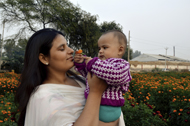Integrating Health Equity Into Climate Change Planning
 From vector-borne diseases to hazard-related injuries, we expect an increase in a multitude of health risks. Certain populations, like tribal communities, communities of color, underinvested rural communities, low-income households, outdoor workers, children, pregnant women and elders are more vulnerable to these health risks.
From vector-borne diseases to hazard-related injuries, we expect an increase in a multitude of health risks. Certain populations, like tribal communities, communities of color, underinvested rural communities, low-income households, outdoor workers, children, pregnant women and elders are more vulnerable to these health risks.
In addition to exasperating current inequities, climate change also presents intergenerational inequities. Since greenhouse gases persist in the atmosphere for centuries, taking action today helps us prepare and protect the future health of our children and grandchildren.
Advancing health equity is at the core of our mission in Oregon’s Public Health Division. The Climate and Health Program is building on this commitment and working toward climate equity, where no person shoulders a heavier burden of climate impacts due to social or economic circumstances.
Oregon Climate Equity Blueprint
As part of our participation in the Oregon Climate Change Adaptation Framework project, OHA led an interagency climate equity workgroup that developed a new Climate Equity Blueprint intended to help Oregon’s State agencies use Justice, Equity, Diversity and Inclusion (JEDI) best practices in climate adaptation planning and action.
Vulnerability Assessment
OHA is currently working with other State agencies to explore how climate vulnerability assessments can be integrated across sectors.
In 2015, OHA published a vulnerability assessment that focuses specifically on social vulnerability as a way to integrate the concepts of social determinants and environmental justice into long-term climate change planning. We hope to build off of this initial set of maps, adding measures of hazard exposures (such as extreme heat) and measures of adaptive capacity (such as air conditioning).
Climate Equity Resources